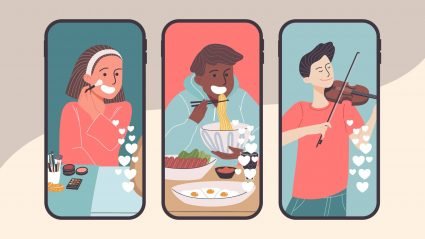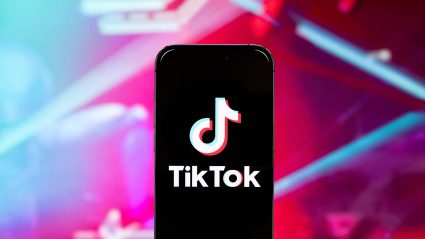Conference season is in full swing, and, after being dazzled by Adweek’s Social Media Week conference in New York (and living out our full Marvelous Mrs. Maisel fantasies at the TWA hotel), we wanted to share what we learned.
The word echoing throughout the conference (which was themed around the Creatorverse) was validation: we heard it everywhere, from talking about where social media is going or which platforms reign supreme right now. It’s not enough to guess in the quickly changing currents of social; marketers want to know they’re making the right decisions.
That’s why, after attending nearly 30 sessions over the course of three days and listening to experts from brands like EOS, Duolingo, Chegg, and Hilton, you need to pay attention to these four critical takeaways.
1) Trust creators to know what content resonates with their audiences
In an era dominated by influencers and viral trends, authenticity has become the holy grail of social media marketing. Duolingo’s VP of Global Marketing, Manu Orssaud, pointed out that creator marketing is the closest thing to scalable word-of-mouth, which couldn’t be more true.
With its perfectly curated For You Page, flash-in-the-pan trends, and stitch and duet capabilities that give users the chance to add their own opinions of videos, TikTok is like having a circle of friends you can rely on in real-time. Consumers are increasingly wary of overly polished, scripted content; they’re looking for genuine and/or relatable experiences from brands.
Duolingo success on TikTok couldn’t have happened without significant trust in the team. Social Media Coordinator Zaria Parvez had free rein to go wild with Duo the Owl on the platform, and the playful content quickly amassed millions of followers, likes, and views for the account. Parvez has since been promoted to Global Social Media Manager, and Duolingo is now known as a pioneer for TikTok content creation.
@duolingo another day another slay #duolingo #legaltok #languagelearning #dulapeep ♬ original sound – Vanessa Sirias
Not all brands are ready to hand the reins fully over to their influencers or creators, even those that they employ full-time. But that may be holding you back: Kate Spade’s VP of North America Marketing, Amanda Bopp, shared that when they “released a bit of control” of social content, the brand saw better results.
If you want to use an influencer/creator to get access to a specific audience, you’re partnering with them because they are an expert on that audience. You need to trust that expertise, so make sure any partners align with your brand’s values and then give them the right resources about your brand and positioning so they can make smart decisions about the content they’re creating on your behalf.
It might not be realistic to completely overhaul your brand guidelines, but you can start by including your creators in your ideation process to get their perspective and expertise into the mix earlier to start reaping the benefits of their authentic voices.
2) Use social listening tools to inform messaging, uncover relevant niches, and drive product development
High-quality content is essential for capturing attention, but it’s not enough: you also have to consider the context in which that content is delivered. An easy way to make sure you’re getting the full picture is by investing in social listening tools that can give your brand insights into conversations as they happen in real-time.
You can leverage a deeper understanding of your audience’s preferences, habits, and social media behavior to tailor your content and messaging for maximum impact. Personal care brand EOS took social listening to the next level with their user-inspired limited edition (NSFW) product line, “Bless Your F#@%ing Cooch.”
@killljoyy♬ original sound – killjoy
After TikTok creator @killljoyyk’s step-by-step tutorial featuring EOS’ shaving cream went viral, the brand created a limited edition line that put her memorable phrases front and center; the bottles even came printed with her directions. Of course, the brand made sure to give her all the credit and gifted her a set of creams.
You should be investing in social listening to build an authentic connection with an audience based on meaningful conversations they’re having about brands. It can generate new ideas for campaigns, content, creative, and more. And, like EOS, you can even potentially turn those insights into even bigger branding and sales opportunities in conjunction with your product teams if they’re generating sufficient buzz and interest.
3) Pay attention to the attention economy as part of your brand strategy
It’s harder to get people’s attention in a world crowded with a lot of noise, and it’s even harder to keep it. And the ever-evolving social media landscape is ground zero in the attention economy. There are more channels, more voices, and more content available to consumers than ever, and brands face an uphill battle to try and find new ways to capture and hold the attention of their target audience.
We’ve already talked about some of the approaches that have generated results for brands like DuoLingo and EOS, like trying out new platforms and partnering with influencers or creators. Both of those examples share something in common: TikTok.
TikTok changed how people consume media: your feed isn’t dictated by who you follow, but by the content you like. And its full-screen, immersive in-app experience and engaging content make it a strong contender for the precious commodity of people’s attention.
Ed tech company Chegg realized that education content using the hashtag #LearnOnTikTok had generated 223 billion views and smelled an opportunity to better connect with prospective clients by doing what they do best: educate.
@cheggmath 🚨NEW TRACK ALERT🚨🔥🔥🔥Duet with your best beat and we might send you a surprise #dopeslopes #EduTok #LearnOnTikTok #LearnWithChegg #Chegg #Math #Geometry ♬ original sound – Chegg Math
Known for their study help, Chegg tapped around 50 influencers to create videos for their @CheggMath account and flooded the niche hashtag with fresh new content. The result? Chegg went from 1.2 million views on TikTok to 513 million, significantly expanding the brand’s awareness.
If you can keep your audience’s attention, you have a better chance of forming a long-term relationship. Those relationships can translate into a sustainable source of revenue that drives long-term growth.
4) Don’t limit yourself to short-form video
The rise of platforms like TikTok and Instagram Reels revolutionized the way brands engage with their audiences, from live streaming to the near-ubiquity of short-form video as a major component of campaigns.
Marketers have long known that video content offers a unique opportunity to captivate viewers and convey messages more dynamically. And the best video strategies are built to encourage user-generated content and foster community participation.
But brands today are focused on very short-form video at the expense of everything else, and that is a mistake. Take Hilton’s 10-minute TikTok video campaign, for example. That video was originally a “back of the deck idea” that actually came to fruition and then generated some serious results.
@hilton Unexpected & amazing things can happen when you stay, and we want you to stay with us for 10 minutes. Yup, we made a 10-minute TikTok AND we’re giving away 10M Hilton Honors Points + more. #HiltonStayFor10 #HiltonForTheStay ♬ Hilton’s 10-Minute Stay – Hilton
Featuring Paris Hilton and TikTok creators Chris Olsen, GirlBossTown, KelzWright, Bomanizer, and more, the mashup let each creator validate the brand value props in a way that resonated with their own audience.
The ad’s viral success was largely driven by Hilton’s (the hotel brand, not the heiress) well-managed influencer strategy. Hilton gave creators a very open-ended brief, encouraging them to take more creative liberties in service of their audiences. The marketers at Hilton made it clear that their customers want to ingest stories, not ads.
Although the video was long, it didn’t seem out of place on the platform because it mimicked short-form videos using formatting and cutting.
You need to prioritize video content and adopt creative storytelling techniques if you want your brand to stay ahead of the curve and make good on the promise to deliver useful, entertaining, or educational content that keeps audiences coming back for more and the brand at the top of the consideration set.
As social media continues to evolve, it’s important to stay ahead of the curve. Learn how to diversify your social strategy with our full guide.







Responses